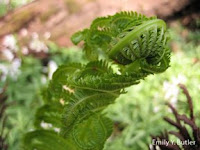If you're interested in collecting Matteuccia fiddleheads yourself, it's very important that you be able to recognize it. There are several other ferns that look similar to Matteucia, including the relatively common Cinnamon Fern, Osmundastrum cinnamomea. However, most ferns are packed with secondary compounds and potential carcinogens, and Matteuccia is the only one deemed acceptable for human consumption.
The pictures above may be helpful in finding this fern. Matteuccia has separate sterile and fertile fronds (known as dimorphic fronds), with the brown fertile ones often emerging first in spring. It is from these that the species gets its common name, Ostrich fern, since they resemble the plumes of an ostrich's tail. Another important identifying character is the groove that runs down the rachis; the fiddleheads and lower part of the rachis will also be covered in golden to brownish scales. If you want to rustle up some fiddleheads yourself, please consult a fern field guide, naturalist, or other expert before consuming anything you collect. Remember, many ferns may contain carcinogens! Also, don't collect every last fiddlehead from one plant, or it won't be able to persist through to the next season.
Last but not least, if you do acquire fiddleheads for your table, let me know how you cook them! Leave a note using the comments button, or email me. I would be very interested to know what works, and perhaps more importantly, what doesn't. I'll leave you with a tasty-sounding recipe I found at the University of Maine Cooperative Extension's website:
Fiddlehead Dijon
1-1/2 pounds fresh fiddleheads
1 tablespoon cornstarch
1 cup nonfat buttermilk
2 teaspoon Dijon mustard
3/4 teaspoon lemon juice
1/2 teaspoon dried tarragon
1/4 teaspoon pepper
Clean and prepare fiddleheads. Remove scales and wash thoroughly. Place fiddleheads in a vegetable steamer over boiling water. Cover and steam 20 minutes or until crisp-tender. Set aside and keep warm.
Combine cornstarch and buttermilk in a small saucepan; stir well. Cook over medium heat until thickened and bubbly, stirring constantly. Remove from heat; stir in mustard, lemon juice, tarragon and pepper.
Arrange fiddleheads on a serving platter. Spoon sauce over fiddleheads. Serve immediately. Yield: 6 servings.
Bon appetit!





7 comments:
I have an edible fern forest from which we make salads, soups, etc...
I am interested in planting these on our NC mountain property. Do you have a sense of whether these will grow in partial sun on a north slope that gets a fair amount of rain and fog?
You can always experiment as to what factors will affect the growth of ferns, e.g., amount of sun exposure, water exposure, etc...
We have lots of edible ferns here in our country which usually grow in moist areas, like in forests, riversides, etc. , such as
http://www.stuartxchange.org/Pako.html
http://www.stuartxchange.org/Pakong-alagdan.html
http://www.stuartxchange.org/PakongBuwaya.html
http://www.stuartxchange.org/Pakong-gubat.html
http://www.stuartxchange.org/Pakongtulog.html
This fern is used extensively in south east asia and japan for cooking. In Indonesia we called it Daun pakis, usually cook in spice and coconut milk.
precisely!!
This is such a great post. I have several acres full of ferns, and many seem to be ostrich ferns. However, I have always been afraid of making an error, so I've left them alone. Although it is too late for them now, I will be examining them for all the characteristics. Thank you.
I take fresh cut fiddleheads and soak them in cold litely salted water for about 10 minutes, gently agitating them to clean them , this also causes most of the brown thin covering to come off and float to the top where it can be removed. Then I drain them really good and place them on a sheet pan so that they do not touch each other, then place them in the freezer for a few hours until they are frozen solid. At this point you can put them in a freezer bag or any container and immediately return them to the freezer. You can then use them at your convenience and they stay bright green and 'fresh' looking, great for cooking. They keep for up to a year or more. In the food industry this is known as 'I.Q.F' or individually quick frozen.
Post a Comment